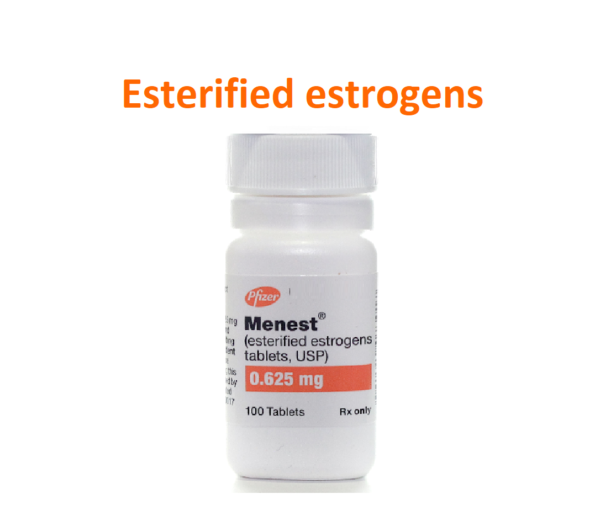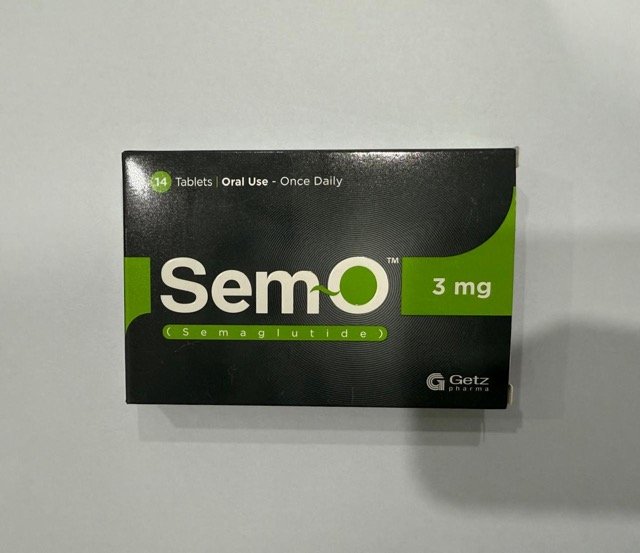Esterified estrogens (Menest) is a synthetic female sex hormone that is used to relieve the symptoms associated with menopause and low female sex hormones in females such as vaginal dryness and atrophy.
Esterified estrogens Uses:
-
Metastatic Breast cancer:
- Palliation is the treatment of metastatic breast cancer in postmenopausal women and adequately chosen men.
-
Hypoestrogenism (female):
- Treatment of primary ovarian failure, hypogonadism, or castration-induced hypoestrogenism
-
Prostate cancer:
- Palliative therapy of advanced prostatic carcinoma.
-
Vasomotor symptoms associated with menopause:
- Treatment of menopause-related moderate to severe vasomotor symptoms
-
Vulvar and vaginal atrophy associated with menopause:
- Treatment of menopause-related vulvar and vaginal atrophy symptoms that range from moderate to severe
- Restrictions on use: Topical vaginal products should be taken into consideration when used only to treat vulvar and vaginal atrophy.
- Note:
- The term "genitourinary syndrome of menopause" (GSM) has been approved as a new word for vulvovaginal atrophy by both the North American Menopause Society and the International Society for the Study of Women's Sexual Health.
- All genital and urinary signs and symptoms brought on by a decline in oestrogen related to menopause are referred to as GSM.
Esterified estrogens (Menest) Dose in Adults
Esterified estrogens (Menest) General dosing guidelines:
- Hormone therapy should be frequently assessed for each patient to determine the best dose, duration, and method of administration depending on treatment objectives, risk factors, and general health.
- For postmenopausal women with uteruses, combined estrogen/progestin therapy is recommended to lower the risk of endometrial cancer.
- In general, people who have had hysterectomies do not require a progestin; however, if endometriosis has a history, one can be required.
- Based on the patient's response, adjust the dose.
Esterified estrogens (Menest) Dose in the treatment of advanced Prostate cancer:
- Oral: 1.25 to 2.5 mg three times a day.
Dose for treating Female hypoestrogenism due to hypogonadism:
- Oral: 2.5 to 7.5 mg divided into two doses per day for 20 days, followed by a 10-day break.
- Repeat the same dose regimen if bleeding has not started by the end of the 10-day period; the number of courses necessary to cause bleeding depends on how sensitive the endometrium is.
- If bleeding starts prior to the 10-day mark, start an estrogen-progestin cyclic regimen of 2.5 to 7.5 mg per day in divided doses for 20 days. During the final five days of oestrogen therapy, provide an oral progestin.
- If bleeding starts before to the regimen's completion, stop treatment and start it again on the fifth day of bleeding.
Dose for treating Female hypoestrogenism due to castration and primary ovarian failure:
- Oral: 1.25 mg cyclically each day (3 weeks on and 1 week off).
- Depending on the severity of the symptoms and the patient's response, adjust the dosage higher or downward.
- Set the dosage for maintenance at the lowest amount necessary to achieve control.
Dose for treating Vasomotor symptoms associated with menopause:
- Oral: 1.25 mg daily, given cyclically (3 weeks on and 1 week off).
- Cyclical administration can be started at any moment if menstrual bleeding has been absent for two months or longer.
- On the fifth day of the patient's menstrual cycle, cyclical administration is initiated.
Dose for treating Vulvar and vaginal atrophy associated with menopause:
- Oral: 0.3 to 1.25 mg per day; start with the lowest dose and increase or decrease according to the patient's response.
- Administer consistently (3 weeks on and 1 week off).
Dose for treating metastatic Breast cancer, (appropriately selected patients):
-
Males and postmenopausal females:
- Orally, take 10 mg three times each day for at least three months.
Esterified estrogens (Menest) Use in Children:
Not indicated.
Esterified estrogens Pregnancy Risk Category: X
- Use of estrogens esterified is not recommended during pregnancy.
- When used in combination with hormonal contraceptives, estrogen and progestin have not been shown to cause teratogenic side effects.
Esterified estrogens use during breastfeeding:
- Breast milk contains estrogens.
- Estrogen has been shown to affect both the quantity and quality of human milk.
- If the medication is to be administered to a nursing woman, it is recommended that caution be taken.
Esterified estrogens (Menest) Dose in Kidney Disease:
Manufacturer's labeling doesn't provide any dosage adjustments; use with caution.
Esterified estrogens (Menest) Dose in Liver disease:
The manufacturer's labeling doesn't provide any dosage adjustments; use is contraindicated with hepatic impairment or dysfunction.
Side effects of Esterified estrogens (Menest):
-
Cardiovascular:
- Cerebrovascular Accident
- Edema
- Myocardial Infarction
- Pulmonary Embolism
- Retinal Thrombosis
- Venous Thromboembolism
- Hypertension
- Local Thrombophlebitis
-
Central Nervous System:
- Chorea
- Dementia (Exacerbation)
- Depression
- Dizziness
- Exacerbation Of Epilepsy
- Headache
- Irritability
- Migraine
- Mood Disorder
- Nervousness
-
Dermatologic:
- Chloasma
- Erythema Multiforme
- Erythema Nodosum
- Pruritus
- Loss Of Scalp Hair
- Skin Rash
- Urticaria
-
Endocrine & Metabolic:
- Change In Libido
- Exacerbation Of Porphyria
- Menstrual Disease (Alterations In Frequency And Flow Of Menstrual Patterns)
- Premenstrual-Like Syndrome
- Weight Gain
- Fibrocystic Breast Changes
- Galactorrhea
- Hirsutism
- Hypocalcemia
- Weight Loss
-
Gastrointestinal:
- Abdominal Cramps
- Gallbladder Disease
- Nausea
- Pancreatitis
- Vomiting
- Bloating
- Carbohydrate Intolerance
-
Genitourinary:
- Breakthrough Bleeding
- Breast Hypertrophy
- Vulvovaginal Candidiasis
- Vaginitis
- Breast Tenderness
- Change In Cervical Ectropion
- Change In Cervical Secretions
- Cystitis-Like Syndrome
- Dysmenorrhea
- Endometrial Hyperplasia
- Nipple Discharge
-
Hematologic & Oncologic:
- Endometrial Carcinoma
- Hemorrhagic Eruption
- Uterine Fibroids (Increased Size)
- Malignant Neoplasm Of Breast
- Malignant Neoplasm Of Ovary
-
Hepatic:
- Cholestatic Jaundice
- Exacerbation Of Hepatic Hemangioma (Enlargement)
-
Hypersensitivity:
- Anaphylactoid Reaction
- Angioedema
- Anaphylaxis
-
Neuromuscular & Skeletal:
- Arthralgia
- Leg Cramps
-
Ophthalmic:
- Contact Lens Intolerance
- Change In Corneal Curvature (Steepening)
-
Respiratory:
- Exacerbation Of Asthma
Contraindications to Esterified estrogens (Menest):
- Hypersensitivity
- Undiagnosed abnormal Genital Bleeding;
- DVT or PE (current and/or historical of);
- Active or recent arterial embombolic disease
- Breast carcinoma
- Known or suspected estrogen-dependent cancer
- Hepatic dysfunction or disease
- Pregnancy known or suspected
Warnings and precautions
-
Breast cancer: [US Boxed Warn]
- According to data from the Women's Health Initiative (WHI), invasive breast cancer is more likely to occur in postmenopausal women who use conjugated estrogens (CE) and medroxyprogesterone (MPA).
- Observational studies show that this risk reduces with discontinuation of medication.
- Hormone therapy may be related to increased breast density. It has been observed that using oestrogen alone or in combination increases the likelihood of abnormal mammography findings that call for additional assessment.
- When oestrogen is used, patients who have bone metastases or breast cancer may develop severe hypercalcemia. If this occurs, stop taking oestrogen.
- According to the WHI trial, women who underwent hysterectomy with CE did not have a higher risk of developing breast cancer.
- As a result of their oestrogen or progestin doses, timing of therapy commencement, length of therapy, mode of administration, and patient characteristics, postmenopausal women undergoing hormone therapy may be more likely to develop breast cancer.
-
Dementia: [US Boxed Warning]
- To prevent dementia, it is not a good idea to use estrogens without or with progestin.
- The Women's Health Initiative Memory Study, (WHIMS) found that women over 65 years old who took CE or combined with MPA had a higher incidence of dementia.
- The WHI memory studies were done on women over 65, but it is not known if the findings can be applied to younger women postmenopausal.
- For the treatment or prevention of cognitive decline or dementia at any age, hormone therapy is not advised.
-
Endometrial Cancer: [US Boxed Warn]
- Women with an intact uterus are more prone to get endometrial cancer.
- To lower the risk of endometrial Hyperplasia, a precursor to endometrial cancer, a progestin may be added to oestrogen therapy.
- It is crucial to carry out the proper diagnostic procedures, including endometrial sampling, if required, in order to rule out cancer in women who have undetected irregular vaginal blood flow.
- The length and dosage of treatment seem to have an impact on the risk of endometrial cancer. For patients who have been receiving therapy for five or more years, it is highest. Even after stopping, this can remain.
- There is no proof that using natural estrogens at equal oestrogen dosages alters the endometrial risk profile from using synthetic estrogens.
- A progestin should not be used if low doses are being administered locally to treat vaginal atrophy. However, there are no long-term data that support this recommendation.
-
Endometriosis:
- Estrogens may exacerbate endometriosis.
- Women with endometrium after hysterectomy should consider adding a progestin.
- Post-hysterectomy with estrogen therapy unopposed has led to malignant transformation of the remaining endometrial implants.
-
Heir to thrombophilia
- Women who have inherited thrombophilia (eg protein C or S deficiencies) might be at greater risk for venous embolism.
-
The Lipid Effects
- Patients with familial lipoprotein metabolism defects may experience an increase in glycerides.
- The lipid effects of estrogenic substances include increased HDL cholesterol or decreased LDL cholesterol.
-
Ovarian cancer:
- The information available regarding the risk of ovarian carcinoma and the use of estrogen/progestin therapy or menopausal estrogen is not consistent.
- An association may exist, but the risk of developing a serious condition is unlikely. The duration of therapy can also influence the likelihood of developing a severe reaction.
-
Retinal vascular embolism:
- Retinal vein thrombosis can be brought on by estrogens.
- Stop if you experience migraine, proptosis or diplopia or any other visual disturbances.
-
Asthma
- Patients with asthma should exercise caution as it can worsen the condition.
-
Carbohydrate intolerance:
- Patients with diabetes may experience impaired glucose tolerance.
- Before starting therapy, you should consider the age, cardiovascular, as well as metabolic risk factors of patients with diabetes.
-
Cardiovascular disease: [US-Boxed Warning]
- To prevent heart disease, estrogens should not be combined with or without progestin.
- According to data from the Women's Health Initiative research, CE increases the risk of deep vein thrombosis and stroke. In addition, postmenopausal females who receive CE have an increased risk of DVT, stroke, and pulmonary emboli (PE).
- Males who have taken estrogens to treat prostate cancer have also experienced adverse cardiovascular events.
- You should manage your risk factors well. If you suspect that adverse cardiovascular events may occur, stop using the medication immediately.
- Other risk factors include hypertension, hypercholesterolemia, hypertension SLE, diabetes mellitus and obesity.
- When treating vasomotor symptoms of menopause in patients at high risk of thrombotic events, transdermal administration is preferable.
- It is not advised for women who have an active DVT, PE, or arterial thromboembolic disorders (stroke and MI).
-
Fluid retention can lead to more severe diseases
- Patients with fluid retention-related diseases, such as renal dysfunction or cardiac disease, should be cautious.
-
Epilepsy:
- Epilepsy can be aggravated if you are careful.
-
Gallbladder disease
- Postmenopausal estrogen use may increase the risk of gallbladder diseases that require surgery.
-
Hepatic dysfunction
- Hepatic disease is a contraindication.
- Stop using if jaundice appears or if there are any acute or long-term hepatic problems.
- Less likely are patients with hepatic impairment to be able to metabolise estrogens.
- If you have ever used oestrogen or been pregnant, you should exercise caution if you have a history of cholestatic jaundice.
-
Hepatic hemomangiomas
- Patients with hepatic hemomangiomas should be cautious; it may worsen the condition.
-
Hypocalcemia:
- Patients with severe hypocalcemia should be cautious.
-
Migraine
- Migraine can be aggravated by taking care.
-
Porphyria
- Patients with porphyria should be cautious as it can worsen the condition.
-
SLE:
- Patients with SLE should be cautious; it may worsen the condition.
[/bg_collapse]
Esterified estrogens: Drug Interaction
|
Risk Factor C (Monitor therapy) |
|
|
Ajmaline |
Estrogen derivatives may intensify ajmaline's harmful or hazardous effects. In particular, there may be an elevated risk for cholestasis. |
|
Anthrax Immune Globulin (Human) |
Anthrax Immune Globulin's thrombogenic action may be enhanced by oestrogen derivatives (Human). |
|
Antidiabetic Agents |
The therapeutic benefit of anti-diabetic agents may be reduced by hyperglycemia-associated agents. |
|
Ascorbic Acid |
May raise the level of oestrogen derivatives in the serum. |
|
Bosentan |
May lower the serum level of CYP3A4 substrates (High risk with Inducers). |
|
Broccoli |
May lower the serum level of CYP1A2 substrates (High risk with Inducers). |
|
C1 inhibitors |
The thrombogenic impact of C1 inhibitors may be enhanced by oestrogen derivatives. |
|
Cannabis |
May lower the serum level of CYP1A2 substrates (High risk with Inducers). |
|
Chenodiol |
Estrogen derivatives may lessen Chenodiol's therapeutic efficacy. When administered with any oestrogen derivative, chenodiol's clinical reaction should be continuously monitored. |
|
Corticosteroids (Systemic) |
Estrogen derivatives may raise the level of corticosteroids in the blood (Systemic). |
|
CYP1A2 Inducers (Moderate) |
May lower the serum level of CYP1A2 substrates (High risk with Inducers). |
|
CYP3A4 Inducers (Moderate) |
May lower the serum level of CYP3A4 substrates (High risk with Inducers). |
|
CYP3A4 Inhibitors (Moderate) |
May raise the level of oestrogen derivatives in the serum. |
|
CYP3A4 Inhibitors (Strong) |
May raise the level of oestrogen derivatives in the serum. |
|
Cyproterone |
May lower the serum level of CYP1A2 substrates (High risk with Inducers). |
|
Dantrolene |
Dantrolene's hepatotoxic action may be enhanced by oestrogen derivatives. |
|
Deferasirox |
May lower the serum level of CYP3A4 substrates (High risk with Inducers). |
|
Erdafitinib |
May lower the serum level of CYP3A4 substrates (High risk with Inducers). |
|
Herbs (Estrogenic Properties) |
Estrogen derivatives' harmful or toxic effects might be amplified. |
|
Immune Globulin |
Estrogen derivatives may intensify Immune Globulin's thrombogenic action. |
|
Ivosidenib |
May lower the serum level of CYP3A4 substrates (High risk with Inducers). |
|
LamoTRIgine |
Estrogen derivatives may lower the level of lamotrigine in the blood. |
|
Lenalidomide |
Lenalidomide's ability to induce thrombosis may be enhanced by oestrogen derivatives. |
|
Mivacurium |
The serum concentration of mivacurium may rise in response to oestrogen derivatives. |
|
Nonsteroidal Anti-Inflammatory Agents (COX-2 Selective) |
Could make oestrogen derivatives' thrombogenic impact stronger. The serum concentration of oestrogen derivatives may rise in response to non-steroidal anti-inflammatory drugs (COX-2 selective). |
|
ROPINIRole |
The serum concentration of ROPINIRole may rise in response to oestrogen derivatives. |
|
Sarilumab |
May lower the serum level of CYP3A4 substrates (High risk with Inducers). |
|
Siltuximab |
May lower the serum level of CYP3A4 substrates (High risk with Inducers). |
|
Succinylcholine |
The serum content of succinylcholine may rise as a result of oestrogen derivatives. |
|
Teriflunomide |
May lower the serum level of CYP1A2 substrates (High risk with Inducers). |
|
Thalidomide |
The thrombogenic effect of thalidomide may be enhanced by oestrogen derivatives. |
|
Theophylline Derivatives |
Theophylline derivatives' serum levels may be raised by oestrogen derivatives. Exceptions: Dyphylline. |
|
Thyroid Products |
Estrogen derivatives may reduce a thyroid product's ability to treat you. |
|
Tocilizumab |
May lower the serum level of CYP3A4 substrates (High risk with Inducers). |
|
Ursodiol |
Ursodiol's therapeutic effects could be lessened by oestrogen derivatives. |
|
Risk Factor D (Consider therapy modification) |
|
|
Anticoagulants |
Estrogen derivatives might lessen an anticoagulant's ability to stop bleeding. More particular, some estrogens and progestin-estrogen combos may have prothrombotic actions that work against any anticoagulant effects. Management: Carefully balance the potential advantages of estrogens against the probable elevated risk of thromboembolism and procoagulant effects. Under some conditions, use is deemed contraindicated. For particular advice, consult the relevant policies. |
|
Cosyntropin |
Cosyntropin's diagnostic potential may be diminished by oestrogen derivatives. Treatment: Stop taking any medications that include oestrogen 4 to 6 weeks before cosyntropin (ACTH) testing. |
|
CYP3A4 Inducers (Strong) |
May speed up CYP3A4 substrate metabolism (High risk with Inducers). Management: Take into account a substitute for one of the interfering medications. Specific contraindications may apply to some combinations. the relevant manufacturer's label. |
|
Dabrafenib |
May lower the serum level of CYP3A4 substrates (High risk with Inducers). Management: When possible, look for substitutes for the CYP3A4 substrate. If concurrent therapy cannot be avoided, pay special attention to the substrate's clinical consequences (particularly therapeutic effects). |
|
Enzalutamide |
May lower the serum level of CYP3A4 substrates (High risk with Inducers). Treatment: Enzalutamide should not be used concurrently with CYP3A4 substrates that have a limited therapeutic index. Enzalutamide use, like with the use of any other CYP3A4 substrate, should be done cautiously and under close observation. |
|
Hyaluronidase |
Estrogen derivatives may lessen Hyaluronidase's therapeutic impact. Treatment: Standard doses of hyaluronidase may not produce the desired clinical response in patients receiving estrogens (especially at higher doses). Hyaluronidase may be needed at higher doses. |
|
Lorlatinib |
May lower the serum level of CYP3A4 substrates (High risk with Inducers). Management: Avoid taking lorlatinib at the same time as any CYP3A4 substrates for which even a small drop in serum levels of the substrate could result in therapeutic failure and negative clinical outcomes. |
|
Mitotane |
May lower the serum level of CYP3A4 substrates (High risk with Inducers). Treatment: When administered in individuals receiving mitotane, doses of CYP3A4 substrates may need to be significantly modified. |
|
Pitolisant |
May lower the serum level of CYP3A4 substrates (High risk with Inducers). Management: Pitolisant should not be used in conjunction with a CYP3A4 substrate that has a limited therapeutic index. When administered with pitolisant, other CYP3A4 substrates need to be checked more carefully. |
|
Pomalidomide |
Could make oestrogen derivatives' thrombogenic impact stronger. Care should be taken while using hormone replacement treatment, and hormonal contraceptives are not advised, according to Canadian pomalidomide labelling. These precise guidelines are not included on the pomalidomide labelling in the US. |
|
Somatropin |
Estrogen derivatives may lessen Somatropin's therapeutic impact. shown to be of concern in postmenopausal women receiving oral hormone replacement treatment. Monitor for decreased growth hormone effectiveness. To get the desired therapy outcome, a higher somatropin dose could be necessary. Non-oral estrogens do not seem to be affected by this interaction (e.g., transdermal, vaginal ring). |
|
St John's Wort |
May lower the serum level of CYP3A4 substrates (High risk with Inducers). Management: Take into account a substitute for one of the interfering medications. Specific contraindications may apply to some combinations. the relevant manufacturer's label. |
|
Tipranavir |
Estrogen derivatives may intensify Tipranavir's unfavourable effect on the skin. A high incidence of skin rash was linked to the use of tipranavir/ritonavir and ethinyl estradiol/norethindrone together. The serum levels of oestrogen derivatives may drop when taking tipranavir. Management: Women who use hormonal contraceptives should think about non-hormonal alternatives. |
|
Risk Factor X (Avoid combination) |
|
|
Anastrozole |
Estrogen derivatives may lessen anastrozole's therapeutic efficacy. |
|
Dehydroepiandrosterone |
Estrogen derivatives' harmful or toxic effects might be amplified. |
|
Exemestane |
Estrogen derivatives may reduce Exemestane's therapeutic efficacy. |
|
Hemin |
Estrogen derivatives may lessen Hemin's therapeutic impact. |
|
Indium 111 Capromab Pendetide |
Indium 111 Capromab Pendetide's diagnostic effectiveness may be reduced by oestrogen derivatives. |
|
Ospemifene |
Estrogen derivatives may intensify Ospemifene's harmful or hazardous effects. Ospemifene's therapeutic efficacy may be lessened by oestrogen derivatives. |
Monitoring parameters:
Females:
- Breast cancer
- CVD.
- Age-appropriate breast and pelvis
- blood pressure;
- Unplanned bleeding for endometrial pathology lasting more than six months (earlier in individuals with diabetes, obesity, or a history of endometrial cancer); serum triglycerides two weeks after beginning medication in those with a baseline level of greater than 200 mg/dL; TSH (6 to
- 12 weeks after starting oral therapy in patients taking thyroid replacement).
Menopausal symptoms:
- Efficacy starts 1 to 3 months after initiating therapy, and thereafter as needed, every 6 to 12 months.
- At the very least once a year, the length of the treatment should be assessed.
Note: Management of vasomotor symptoms or GSM does not benefit from monitoring FSH and serum oestrogen levels.
How to administer?
It can be given without taking a meal.
Mechanism of action of Esterified estrogens (Menest):
- Combinations of estrogenic chemicals make up esterified estrogens.
- Estrone is the main ingredient.
- The amounts of sodium estrone sulphate and sodium equilin sodium sulphate in the formulations range from 75% to 85% and 6% to 15%, respectively.
- This indicates that they are not greater than 90%. Estrogens are essential for the growth and upkeep of the female reproductive system as well as the development of secondary sexual traits.
- The primary intracellular human oestrogen, estradiol, is more powerful at the receptor level than estrone or estriol. Additionally, it is the main oestrogen released prior to menopause.
- After menopause, males have higher levels of estrone and estrone succate than females do.
- Estrogens control pituitary gonadotropin, luteinizing hormone, and follicle stimulating hormone release through a negative feedback mechanism.
- Estrogen replacement decreases high levels of these hormones.
Absorption:
- Readily
Distribution:
- Widely distributed;
- High levels in the areas that sex hormones target
Protein binding:
- Albumin and sex hormone-binding globulin
Metabolism:
- Hepatic partial metabolism via CYP3A4 enzymes;
- Estradiol undergoes enterohepatic recirculation via conjugation in the liver, followed by excretion of sulphate and glucuronide conjugates into the bile, then hydrolysis in the gut and oestrogen reabsorption. Estradiol is reversibly transformed to estrone and estriol.
- The main type identified in postmenopausal women is sulphate conjugates.
Excretion:
- Urine is primarily (as estrone, estriol, estradiol, and their glucuronide and sulphate conjugates)
International Brand Names of Esterified estrogens:
- Estragyn
- Menest
Esterified estrogens Brand Names in Pakistan:
There is no brand available in Pakistan.



.jpeg)



